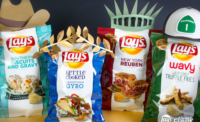For the U.S. retail food sector, the children aren't just the future, they are very much the present. And what they’re interested in eating is being shaped by the fact that they have Millennial parents, there’s more multicultural children and the childhood obesity epidemic.
And while parents may earn the money to make necessary household purchases, they -- more often than not -- acquiesce to the demands and preferences of their children when it comes to grocery shopping.
Whether it’s a brand of cereal, candy, soda, and anything beyond or in between, it's clear that kids — as much as word of mouth from other parents, advertisements, or the internet — influence consumer awareness of food and beverage products.
In fact, more than a quarter of parents (26 percent) learn about a new product as a request from their child, according to market research publisher Packaged Facts in the brand-new report, Kids Food and Beverage Market in the U.S., 8th Edition.
Kids age six and older are a particularly important demographic to marketers. Life-long dietary habits are established during this time period and brand loyalty begins. This suggests industry players should focus on product development designed to capture younger kids and gain allegiance from parents earlier to keep them involved with the brand throughout childhood and beyond.
"It's the circle of retail life. Child demands product, parent learns about product through child, household begins using product, child ideally grows up to encourage his or her own household to use said product — at least until their own kids start making requests," says David Sprinkle, research director, Packaged Facts.
Developing products that effectively appeal to children is more difficult than it sounds.
The kids' food and beverage market is particularly challenging because industry players have to market to both the end users (the child) and the purchaser (the parent). To that end, understanding trends and factors that influence kids' food purchases can provide industry players with strategies to better position their company and brands within the market.
In Kids Food and Beverage Market in the U.S., 8th Edition, Packaged Facts identifies three mega trends that have and will continue to shape the market for foods created for and marketed to children.
These include:
1. Millennial parents
In 2015, Millennial parents accounted for 42 percent of all households with children, making them an important segment of the parenting demographic. Additionally, this group will likely continue to represent a growing share of households with children because the Millennial generation spans nearly two decades — some are still in school and dependent on their parents and have not yet reached the childrearing stage.
Millennials also comprise a larger share of lower-income households. On the surface, this would imply that Millennials are on strict budgets and that affordability is a significant purchase decision influence. While this may be true, it's also important to consider the Millennial mindset toward spending: Millennials are willing to spend extra for perceived higher quality products and services. Notably, they value transparency, authenticity and brands that represent them and their lifestyles.
For example, Millennial Moms tend to place importance on foods that are natural and do not contain artificial ingredients. Healthier, yet affordable, foods are very important to these parents. Simply put, they don't want to compromise the nutritional value of the foods they buy, especially for their children.
2. Multicultural households
Race/ethnicity is an important consideration for kids' food and beverage makers and marketers. Some 28 percent of white households have children living in the home, which translates to about 24.9 million households.
However, some 50 percent of Hispanic households have children living in the home, followed by 44 percent of black households and 40 percent of Asian households. For industry players, this means targeting households across the cultural spectrum is one way to hone marketing efforts to ensure reach of a high concentration of families.
Targeting the multicultural parent requires marketers to leverage strategies in order to appeal to traditional cultural values: advertising in Spanish is an obvious example of this approach to better communicate with Hispanic parents. Marketers should also understand family values of the multicultural consumer; for example, extended families (such as grandparents, aunts, and uncles) can also be tapped as potential additional purchasers for kids' food and beverage.
3. Childhood obesity
Over the past 20 years, the prevalence of obesity has risen not only among adults but children as well. Forward thinking makers and marketers will continue to serve as advocates of kids' health and take necessary action to improve the nutrition and health profile of foods and beverages marketed toward kids, with improved market performance as their reward.
One way industry players are providing healthier kid-friendly food and beverage products is through the stealth health movement, which helps parents to increase kids' fruit and veggie intake while still retaining kid appeal. The stealth health premise is that by hiding servings of fruits and veggies in kid-friendly foods like pastas, pizzas, breads, smoothies, and desserts, that kids will more easily meet daily nutritional requirements. The trend has emerged in product development in nearly every market segment of kids' food and beverages.
Beyond stealth health, better-for-you (BFY) kids' food and beverage is also being tapped through the real food movement. The real food concept incorporates health, animal welfare, social justice and environmental sustainability — buzzwords that fit under this umbrella are "clean," "local," "green," or "slow," as well as "fair" and "organic."
Overall, Kids Food and Beverage Market in the U.S., 8th Edition report analyzes and trends seven food and beverage categories significant to children's eating choices, usage occasions and need states, including breakfast foods, lunch foods, and dinner foods; sweet snacks and salty snacks; produce; and beverages.
Each category analysis includes trended usage of specific foods and beverages over a ten-year period (2006-2015) among households, drilling into households with children by key demographics (in particularly parents' gender, generation, and HH income). Marketing strategies and product innovation relevant to each category's position in the kids' food and beverage market is also included, with careful consideration of how marketers are satisfying the needs and interests of both parents and kids.
To purchase the report or for more information, including the table of contents and the abstract, visit the Packaged Facts website.





